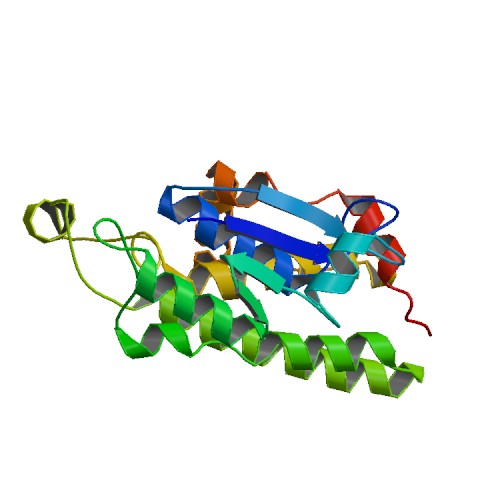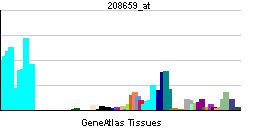CLIC1
| Chloride intracellular channel 1 | |||||||||||||
|---|---|---|---|---|---|---|---|---|---|---|---|---|---|
 PDB rendering based on 1k0m. | |||||||||||||
| |||||||||||||
| Identifiers | |||||||||||||
| Symbols | CLIC1 ; G6; NCC27 | ||||||||||||
| External IDs | Template:OMIM5 Template:MGI HomoloGene: 20343 | ||||||||||||
| |||||||||||||
| RNA expression pattern | |||||||||||||
 | |||||||||||||
| More reference expression data | |||||||||||||
| Orthologs | |||||||||||||
| Template:GNF Ortholog box | |||||||||||||
| Species | Human | Mouse | |||||||||||
| Entrez | n/a | n/a | |||||||||||
| Ensembl | n/a | n/a | |||||||||||
| UniProt | n/a | n/a | |||||||||||
| RefSeq (mRNA) | n/a | n/a | |||||||||||
| RefSeq (protein) | n/a | n/a | |||||||||||
| Location (UCSC) | n/a | n/a | |||||||||||
| PubMed search | n/a | n/a | |||||||||||
Chloride intracellular channel 1, also known as CLIC1, is a human gene.[1]
Chloride channels are a diverse group of proteins that regulate fundamental cellular processes including stabilization of cell membrane potential, transepithelial transport, maintenance of intracellular pH, and regulation of cell volume. Chloride intracellular channel 1 is a member of the p64 family; the protein localizes principally to the cell nucleus and exhibits both nuclear and plasma membrane chloride ion channel activity.[1]
References
Further reading
- Okubo K, Hori N, Matoba R; et al. (1994). "Large scale cDNA sequencing for analysis of quantitative and qualitative aspects of gene expression". Nat. Genet. 2 (3): 173–9. doi:10.1038/ng1192-173. PMID 1345164.
- Frigerio JM, Berthézène P, Garrido P; et al. (1995). "Analysis of 2166 clones from a human colorectal cancer cDNA library by partial sequencing". Hum. Mol. Genet. 4 (1): 37–43. PMID 7711732.
- Liew CC, Hwang DM, Fung YW; et al. (1994). "A catalogue of genes in the cardiovascular system as identified by expressed sequence tags". Proc. Natl. Acad. Sci. U.S.A. 91 (22): 10645–9. PMID 7938007.
- Maruyama K, Sugano S (1994). "Oligo-capping: a simple method to replace the cap structure of eukaryotic mRNAs with oligoribonucleotides". Gene. 138 (1–2): 171–4. PMID 8125298.
- Valenzuela SM, Martin DK, Por SB; et al. (1997). "Molecular cloning and expression of a chloride ion channel of cell nuclei". J. Biol. Chem. 272 (19): 12575–82. PMID 9139710.
- Heiss NS, Poustka A (1997). "Genomic structure of a novel chloride channel gene, CLIC2, in Xq28". Genomics. 45 (1): 224–8. doi:10.1006/geno.1997.4922. PMID 9339381.
- Suzuki Y, Yoshitomo-Nakagawa K, Maruyama K; et al. (1997). "Construction and characterization of a full length-enriched and a 5'-end-enriched cDNA library". Gene. 200 (1–2): 149–56. PMID 9373149.
- Tulk BM, Edwards JC (1998). "NCC27, a homolog of intracellular Cl- channel p64, is expressed in brush border of renal proximal tubule". Am. J. Physiol. 274 (6 Pt 2): F1140–9. PMID 9841507.
- Chuang JZ, Milner TA, Zhu M, Sung CH (1999). "A 29 kDa intracellular chloride channel p64H1 is associated with large dense-core vesicles in rat hippocampal neurons". J. Neurosci. 19 (8): 2919–28. PMID 10191309.
- Ribas G, Neville M, Wixon JL; et al. (1999). "Genes encoding three new members of the leukocyte antigen 6 superfamily and a novel member of Ig superfamily, together with genes encoding the regulatory nuclear chloride ion channel protein (hRNCC) and an N omega-N omega-dimethylarginine dimethylaminohydrolase homologue, are found in a 30-kb segment of the MHC class III region". J. Immunol. 163 (1): 278–87. PMID 10384126.
- Berryman M, Bretscher A (2000). "Identification of a novel member of the chloride intracellular channel gene family (CLIC5) that associates with the actin cytoskeleton of placental microvilli". Mol. Biol. Cell. 11 (5): 1509–21. PMID 10793131.
- Tonini R, Ferroni A, Valenzuela SM; et al. (2000). "Functional characterization of the NCC27 nuclear protein in stable transfected CHO-K1 cells". FASEB J. 14 (9): 1171–8. PMID 10834939.
- Valenzuela SM, Mazzanti M, Tonini R; et al. (2001). "The nuclear chloride ion channel NCC27 is involved in regulation of the cell cycle". J. Physiol. (Lond.). 529 Pt 3: 541–52. PMID 11195932.
- Harrop SJ, DeMaere MZ, Fairlie WD; et al. (2002). "Crystal structure of a soluble form of the intracellular chloride ion channel CLIC1 (NCC27) at 1.4-A resolution". J. Biol. Chem. 276 (48): 44993–5000. doi:10.1074/jbc.M107804200. PMID 11551966.
- Warton K, Tonini R, Fairlie WD; et al. (2002). "Recombinant CLIC1 (NCC27) assembles in lipid bilayers via a pH-dependent two-state process to form chloride ion channels with identical characteristics to those observed in Chinese hamster ovary cells expressing CLIC1". J. Biol. Chem. 277 (29): 26003–11. doi:10.1074/jbc.M203666200. PMID 11978800.
- Shanks RA, Larocca MC, Berryman M; et al. (2002). "AKAP350 at the Golgi apparatus. II. Association of AKAP350 with a novel chloride intracellular channel (CLIC) family member". J. Biol. Chem. 277 (43): 40973–80. doi:10.1074/jbc.M112277200. PMID 12163479.
- Strausberg RL, Feingold EA, Grouse LH; et al. (2003). "Generation and initial analysis of more than 15,000 full-length human and mouse cDNA sequences". Proc. Natl. Acad. Sci. U.S.A. 99 (26): 16899–903. doi:10.1073/pnas.242603899. PMID 12477932.
- Fan L, Yu W, Zhu X (2003). "Interaction of Sedlin with chloride intracellular channel proteins". FEBS Lett. 540 (1–3): 77–80. PMID 12681486.
- Mungall AJ, Palmer SA, Sims SK; et al. (2003). "The DNA sequence and analysis of human chromosome 6". Nature. 425 (6960): 805–11. doi:10.1038/nature02055. PMID 14574404.
- Littler DR, Harrop SJ, Fairlie WD; et al. (2004). "The intracellular chloride ion channel protein CLIC1 undergoes a redox-controlled structural transition". J. Biol. Chem. 279 (10): 9298–305. doi:10.1074/jbc.M308444200. PMID 14613939.
| This protein-related article is a stub. You can help Wikipedia by expanding it. |